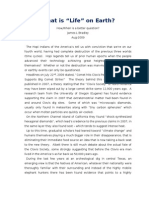Yonaguni Submerged Structures
Yonaguni Submerged Structures
Uploaded by
KembaraLangitCopyright:
Available Formats
Yonaguni Submerged Structures
Yonaguni Submerged Structures
Uploaded by
KembaraLangitOriginal Description:
Copyright
Available Formats
Share this document
Did you find this document useful?
Is this content inappropriate?
Copyright:
Available Formats
Yonaguni Submerged Structures
Yonaguni Submerged Structures
Uploaded by
KembaraLangitCopyright:
Available Formats
by Laura Lee
from LauraLee Website
YONAGUNI: The ancient underwater pyramid structure off the coast of Yonaguni-jima, Japan
Man-made, made by Nature, or did humankind finish what Nature started? These enigmatic, sunken stone
structures off Okinawa, Japan, located 60 to 100 feet beneath the ocean surface, have the Japanese
wondering if their homeland was once part of the lost continent of Mu.
Stone terraces, right angled block and walls, and stone circles
encompassing hexagonal columns look intriguingly, if not conclusively,
man made. A few more clues: an encircling road, what might be post
holes supported long-gone wooden structures, what look like cut
steps, and castles with similar architecture located nearby and still on
land. (see photos; link at end of this article)
The two sites that are getting the most attention: near the city of Naha
is Okinawa is what looks like a wall, with a coral encrusted right
angled block. Another, just off the southern end of the tiny island of
Yonaguni, the southernmost island of Japan, is an extensive site, with
five irregular layers that look like ceremonial, terraced platforms. There
are eight anomalous, underwater sites found to date.
Prof. Masaaki Kimura, a marine geologist with the University of the
Ryukyus in Okinawa has spent several years studying all eight sties,
especially Yonaguni, which was found 13 years ago, in 1985.
Kimura believes these are monuments made by man, left by an
unknown civilization, perhaps from the Asian mainland, home of our
oldest civilizations. He reasons that if the five layers on the Yonaguni site had been carved by nature, you
would find debris from the erosion to have collected around the site, but no rock fragments have yet been
found. He adds that there is what look like a road encircling the site as further indication it was used by man.
He believes building this monument necessitated a high degree of technology, and some sort of machinery.
How to date these sites? A few possible scenarios have been suggested. The sites may have been
submerged when sea levels rose at the end of the last Ice Age as the continental ice sheets melted. Or, as
Japan sits on the Ring of Fire, tectonic activity might have caused subsidence of the land. Or perhaps a
combination of subsidence and inundation from rising sea levels, or some catastrophic event, dropped it,
intact and upright, into the ocean.
Teruaki Ishii, a professor of geology at Tokyo
University, believes the site is partly man-made, partly
natural, and suggests a date of 8,000 B.C.,
contemporary to the ancient civilizations of
Mesopotamia and the Indus Valley. Others have
suggested a date of 12,000 years.
The preliminary reports from the fist Americans to dive
the sites:
Just back (May 1998) from diving two of the eight
known sites are Mike Arbuthnot, an amateur
underwater archeologist adventurer, and Boris Said, Executive Producer of the NBC documentary, "Mystery
of the Sphinx." Both are experienced divers. Arbuthnot explored a three-mast schooner wrecked off Grand
Cayman Island, and Said has been diving for 40 years.
It was treacherous terrain even for experienced divers. "The Yonaguni site is fairly near the shore, so there
was heavy surge (the up and down motion of waves) as well as swift currents, and sharks," says Arbuthnot.
"One the up side, the area has the third clearest water in the world, with visibility to 200 feet. And the corals
were gorgeous."
"The two sites are very different, though both are at a comparable depth, 60 to 100 feet beneath the ocean’s
surface. The Yonaguni site might be ceremonial platforms, and the Okinawa site seems similar to a castle
wall, a conjecture that is supported by nearby castles on the island with a similar architectural style," says
Arbuthnot.
Arbuthnot says that when he came up after the first dive, at Yonaguni, he found little to suggest that it was
man made. It was only after diving the Okinawa site, and interviewing Prof. Kimura for two days, that he
began to entertain the notion. The conversations with Prof. Kimura were all the more productive and in-depth,
with the translating skills of Corina Tettinger, who speaks fluent Japanese.
"The case for the sites being artificial, or modified by man, requires supporting evidence," he says, and "we
found very precise rectilinear stone features that seem to be indicative of either artificial tooling, or modifying
the natural geology."
A particularly intriguing find: holes in the rock platforms. Could these
be post holes to support a wooden structure? The terraces are
massive, by human standards. But we can imagine naturally
terraced platforms easily utilized for ceremonial purposes with the
addition of wooden structures built atop them. You’d simply need to
insert the supporting beams into the rock, by drilling a few holes.
"What we were able to observe was fascinating and warrants
additional research," he says. "There is some false information on
the sites out there. We want to bring clarity to the situation, and
intend to mount a full-scale scientific expedition to do further
investigation."
We'll report new developments on this project as they happen.
Geologist Robert Schoch and
Egyptologist John Anthony West (both
featured in the NBC documentary "The
Mystery of the Sphinx") dove many
months ago at Yonaguni, also without
arriving at any conclusions, only more
questions. Schoch focused on determining
what geological forces might have been at
work here.
While he notes that the strong currents
might have cut the terraces out of the
layered sediments, he has not ruled out
human modification. Schoch says he very
much wants to go back to dive again
before arriving at any conclusions.
"I have not seen the other sites," he says, "and, not having previous diving experience, I spent much of my
time underwater just staying alive.
You might also like
- UFO Contact From Planet Korendor (Bob Renaud) (Z-Library)Document138 pagesUFO Contact From Planet Korendor (Bob Renaud) (Z-Library)crmm1961No ratings yet
- Eccentric Lives and Peculiar Notions (John Michell)Document3 pagesEccentric Lives and Peculiar Notions (John Michell)Emir DelicNo ratings yet
- Alien Contact: Verbatim Extracts From The Smith ArchiveDocument4 pagesAlien Contact: Verbatim Extracts From The Smith ArchiveAnton DremlyugaNo ratings yet
- Egyptian Myth and LegendDocument179 pagesEgyptian Myth and LegendGuðríður Margrét GuðmundsdóttirNo ratings yet
- Subject Ufo Crashes and Retrievals FileDocument4 pagesSubject Ufo Crashes and Retrievals FileMarcusNo ratings yet
- The Dropa Stones, China.Document3 pagesThe Dropa Stones, China.Shree Vishnu ShastriNo ratings yet
- Sinking of Atlantis by Nibiru in 9577 BC: Part 2, Mechanics of SinkingDocument13 pagesSinking of Atlantis by Nibiru in 9577 BC: Part 2, Mechanics of SinkingAnonymous HsoXPyNo ratings yet
- The New Church Repository and Monthly Re Vol V 1852Document578 pagesThe New Church Repository and Monthly Re Vol V 1852francis battNo ratings yet
- Thecast Newsletter Issue 9Document7 pagesThecast Newsletter Issue 9Machiavelli DavisNo ratings yet
- PaleoSeti Magazine Issue 2Document32 pagesPaleoSeti Magazine Issue 2Celso GarciaNo ratings yet
- A Hypnotist S Journey To The Secrets of The Sphinx A HypnotistsDocument273 pagesA Hypnotist S Journey To The Secrets of The Sphinx A HypnotistsLumy FoxNo ratings yet
- Lost Civilizations of The AndesDocument61 pagesLost Civilizations of The AndesSohrab100% (1)
- Lost Civilizations of The AndesDocument71 pagesLost Civilizations of The AndesSohrabNo ratings yet
- Why Haven't The Aliens Invaded AlreadyDocument3 pagesWhy Haven't The Aliens Invaded AlreadybasharfanNo ratings yet
- MangalyaanDocument13 pagesMangalyaanAmeshNo ratings yet
- Structuri MegaliticeDocument13 pagesStructuri MegaliticeFiru CristinaNo ratings yet
- Intelligent Life in The UniverseDocument124 pagesIntelligent Life in The UniverseVidriotesNo ratings yet
- AttisDocument6 pagesAttisKembaraLangitNo ratings yet
- 8-14-09 What Is "Life" On EarthDocument18 pages8-14-09 What Is "Life" On EarthJames BradleyNo ratings yet
- Evidencia Centéfica BigfootDocument24 pagesEvidencia Centéfica BigfootMarianCondeNo ratings yet
- Blowing CaveDocument5 pagesBlowing CaveNikša StanojevićNo ratings yet
- Stiebing, Ancient Astronauts 1992Document3 pagesStiebing, Ancient Astronauts 1992Herbert Adam StorckNo ratings yet
- Erich Von Daniken The Gold of The Gods PDFDocument2 pagesErich Von Daniken The Gold of The Gods PDFDawnNo ratings yet
- Life On VenusDocument2 pagesLife On VenusliubingxyNo ratings yet
- The Great Flood The Eridu GenesisDocument3 pagesThe Great Flood The Eridu GenesisMorenaMoraNo ratings yet
- The Date of The Lost Cities of Dvaravati and Atlantis PDFDocument3 pagesThe Date of The Lost Cities of Dvaravati and Atlantis PDFSHIVAM SINGHNo ratings yet
- Moon LandingDocument4 pagesMoon Landingapi-330766253No ratings yet
- (1921) Stone Statues of NicaraguaDocument12 pages(1921) Stone Statues of NicaraguaHerbert Hillary Booker 2ndNo ratings yet
- Ernest P. Moyer: Spirit Entry Into Human MindDocument199 pagesErnest P. Moyer: Spirit Entry Into Human MindLuis Marco100% (1)
- 시리우스 미스터리Document10 pages시리우스 미스터리0514bachNo ratings yet
- Lost Cities - Jonathan GrayDocument103 pagesLost Cities - Jonathan Graykaliyuga123No ratings yet
- The Search For Extraterrestrial LifeDocument1 pageThe Search For Extraterrestrial LifeSafeModeNo ratings yet
- Paul Davies Alone in The Universe PDFDocument2 pagesPaul Davies Alone in The Universe PDFn451683No ratings yet
- 2013 Aguadilla Puerto Rico UAP Final Draft v5sDocument162 pages2013 Aguadilla Puerto Rico UAP Final Draft v5sroyidohinNo ratings yet
- Age of Hinduism - Kalpa VigrahaDocument1 pageAge of Hinduism - Kalpa VigrahaAbhijit DasguptaNo ratings yet
- Mars and The Great Galactic GhoulDocument6 pagesMars and The Great Galactic GhoulDan CosteaNo ratings yet
- 221 - List 151 Man Myth & MagicDocument64 pages221 - List 151 Man Myth & Magicsam410No ratings yet
- Bbltk-M.a.o. Lp-337 World's Best True Ufo Stories - Vicufo2Document97 pagesBbltk-M.a.o. Lp-337 World's Best True Ufo Stories - Vicufo2victorNo ratings yet
- Glacial Geomorphology Stratigraphy Doors Peninsula WisconsinDocument228 pagesGlacial Geomorphology Stratigraphy Doors Peninsula WisconsinBaculites100% (1)
- Is Our Brain Really Necessary-LorberDocument3 pagesIs Our Brain Really Necessary-Lorberbigjon1359100% (2)
- What The Dixon Relic Actually MeansDocument23 pagesWhat The Dixon Relic Actually Meansjerry krothNo ratings yet
- The Face On MarsDocument18 pagesThe Face On MarsplcmanaNo ratings yet
- A Jiroft Stone ArtifactDocument13 pagesA Jiroft Stone ArtifactCliffNo ratings yet
- The Enigma of Tiwanaku and Puma Punku by Brien FoersterDocument146 pagesThe Enigma of Tiwanaku and Puma Punku by Brien Foerstermarinboy55100% (2)
- Wenke, The Evolution of EarlyDocument52 pagesWenke, The Evolution of Earlygeonda2011No ratings yet
- Alien Mind - A PrimerDocument229 pagesAlien Mind - A PrimerLex TaylorNo ratings yet
- The Stone Rings of GlozelDocument17 pagesThe Stone Rings of GlozelTaurīni100% (1)
- Yacov Blumkin NIBIRUDocument4 pagesYacov Blumkin NIBIRUCondor7tNo ratings yet
- Wayne Grady-The Bone Museum - Travels in The Lost Worlds of Dinosaurs and Birds-Basic Books (2001) PDFDocument303 pagesWayne Grady-The Bone Museum - Travels in The Lost Worlds of Dinosaurs and Birds-Basic Books (2001) PDFPatricio FernándezNo ratings yet
- Ancient Dinosaurs and Modern Man: Did They Exist Together?Document48 pagesAncient Dinosaurs and Modern Man: Did They Exist Together?A. HeraldNo ratings yet
- The Lost Lemuria by W. Scott-Elliot, 1904Document27 pagesThe Lost Lemuria by W. Scott-Elliot, 1904Gaurav SharmaNo ratings yet
- Lambert Dolphin 5 13 14 FinalDocument7 pagesLambert Dolphin 5 13 14 Finalapi-369102829No ratings yet
- Interview With Occultist Mitch Horowitz, Purple Magazine, The Magic Issue, #42Document4 pagesInterview With Occultist Mitch Horowitz, Purple Magazine, The Magic Issue, #42Mitch HorowitzNo ratings yet
- Mysteries of Siberia's "Valley of Death"Document42 pagesMysteries of Siberia's "Valley of Death"Peon100% (1)
- Greene Journal of Near Death Studies - 1999!17!151 191Document41 pagesGreene Journal of Near Death Studies - 1999!17!151 191360DNo ratings yet
- All Things AlienDocument23 pagesAll Things Alienfreaky-mario3327100% (2)
- Keel Disneyland OCRDocument87 pagesKeel Disneyland OCRPaulo Fleury100% (1)
- The Message of The Engraved Stones of IcaDocument331 pagesThe Message of The Engraved Stones of Icalincoln-6-echo100% (4)
- Journey to the Center of the Earth "The Shasta Mountain Special Forces"From EverandJourney to the Center of the Earth "The Shasta Mountain Special Forces"No ratings yet
- News Coverage of Alleged Cannibalism IncidentsDocument18 pagesNews Coverage of Alleged Cannibalism IncidentsKembaraLangitNo ratings yet
- The Origin of EvilDocument12 pagesThe Origin of EvilKembaraLangit100% (1)
- The 5G Electromagnetic Mad ZoneDocument21 pagesThe 5G Electromagnetic Mad ZoneKembaraLangit100% (1)
- Seven VolcanoesDocument3 pagesSeven VolcanoesKembaraLangitNo ratings yet
- 5G Telecommunications ScienceDocument11 pages5G Telecommunications ScienceKembaraLangitNo ratings yet
- AttisDocument6 pagesAttisKembaraLangitNo ratings yet
- Isis Is A Virgin MotherDocument27 pagesIsis Is A Virgin MotherKembaraLangit100% (2)
- Indonesian UFO Case Review 2010Document34 pagesIndonesian UFO Case Review 2010KembaraLangitNo ratings yet
- Earthquake Glowing CloudsDocument5 pagesEarthquake Glowing CloudsKembaraLangitNo ratings yet
- Aliens A To ZDocument23 pagesAliens A To ZKembaraLangit100% (2)
- CMFB Vol 1 General DesignDocument52 pagesCMFB Vol 1 General Designani4576No ratings yet
- Strike The Blood, Vol. 1Document221 pagesStrike The Blood, Vol. 1Fabio ChulucNo ratings yet
- 45 Minutes-75 Questions: English TestDocument13 pages45 Minutes-75 Questions: English TestdaliaNo ratings yet
- Car Number Plate Detection Using MATLAB and Image ProcessingDocument29 pagesCar Number Plate Detection Using MATLAB and Image Processingحسان فضل الشعيبيNo ratings yet
- Interesting Facts About IndonesiaDocument1 pageInteresting Facts About Indonesiaplaylist2301No ratings yet
- Ambiente Marino Proundo-Abanicos SubmarinosDocument15 pagesAmbiente Marino Proundo-Abanicos SubmarinosJefferson Eras100% (1)
- The Submerged Kumari Continent The Home - MaSo VictorDocument568 pagesThe Submerged Kumari Continent The Home - MaSo VictorAnime FreakNo ratings yet
- Ilmuguru - Org - Soal PAT Bahasa Inggris Kelas 7Document4 pagesIlmuguru - Org - Soal PAT Bahasa Inggris Kelas 7evelyne serafee100% (6)
- Theories On The Origin of The PhilippinesDocument4 pagesTheories On The Origin of The PhilippinesRonaldNo ratings yet
- Geography PowerpointDocument18 pagesGeography Powerpointapi-530119088No ratings yet
- Physical & Human GeographyDocument40 pagesPhysical & Human GeographyTarsisius MagarNo ratings yet
- Natural Wonders of The World: With - HTMLDocument9 pagesNatural Wonders of The World: With - HTMLюлія ласNo ratings yet
- Caribbean Studies - Lesson 1 - Definition of CaribbeanDocument21 pagesCaribbean Studies - Lesson 1 - Definition of CaribbeanJonaé Davidson MadamLegacyNo ratings yet
- 20 Soal Writing IeltsDocument34 pages20 Soal Writing IeltsCahyo Ady NugrahaNo ratings yet
- Financial Times World Desk ReferenceDocument5 pagesFinancial Times World Desk ReferenceNick PapasNo ratings yet
- Ielts Reading Test 2 c15Document7 pagesIelts Reading Test 2 c15minhlynguyen3010No ratings yet
- World Bank List of EconomiesDocument3 pagesWorld Bank List of EconomiesdeepakNo ratings yet
- NCERT Solutions For Class 11 Geography Chapter 2 Structure and PhysiographyDocument2 pagesNCERT Solutions For Class 11 Geography Chapter 2 Structure and PhysiographyMAHIPAL SINGHNo ratings yet
- 02-Windrose - Raja-Ampat-16-05-15ADocument21 pages02-Windrose - Raja-Ampat-16-05-15Amikiway9No ratings yet
- Meeting 12Document14 pagesMeeting 12Ratih KuswidyasariNo ratings yet
- Assignment - The Origin of The PhilippinesDocument2 pagesAssignment - The Origin of The PhilippinesHymarVannTumimbangNo ratings yet
- Contoh Soal ReadingDocument2 pagesContoh Soal ReadingRama-kunNo ratings yet
- LandformsDocument19 pagesLandformsUtkarsh SinghNo ratings yet
- Geography: Chapter 2 Physical Features of India TopicsDocument5 pagesGeography: Chapter 2 Physical Features of India TopicsAbhinav BaliyanNo ratings yet
- The PacificDocument89 pagesThe Pacificarieslabuyo.jcNo ratings yet
- Lakes, Islands and Straits - pdf-67Document7 pagesLakes, Islands and Straits - pdf-67lolu pandeyNo ratings yet
- Geomorphology in The First Half of The Twentieth CenturyDocument22 pagesGeomorphology in The First Half of The Twentieth CenturyMohammed AljaroushiNo ratings yet
- Inggris 2Document32 pagesInggris 2dhe darmawanNo ratings yet
- Landmasses and Bodies of Water Surrounding The PhilippinesDocument18 pagesLandmasses and Bodies of Water Surrounding The PhilippinesCaloykOoy Danday Dueñas100% (2)
- Reading TOEFL 3Document20 pagesReading TOEFL 3Najib100% (1)


































































































